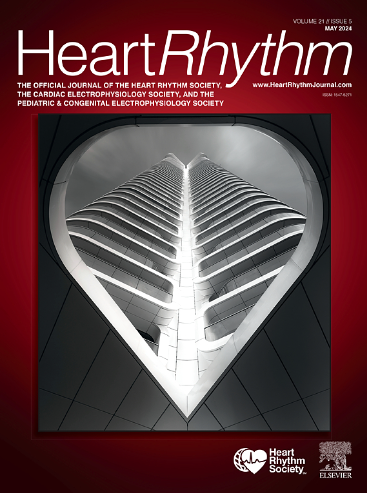Comparison of acute hemodynamic effect of prioritizing ventricular resynchronization vs left ventricular filling during optimization of cardiac resynchronization therapy
IF 5.6
2区 医学
Q1 CARDIAC & CARDIOVASCULAR SYSTEMS
引用次数: 0
Abstract
Background
Targeting maximal ventricular resynchronization, with the shortest QRS duration (QRSd), is commonly implemented after cardiac resynchronization therapy (CRT).
Objective
The purpose of this study was to compare optimization of ventricular resynchronization with optimization of left ventricular (LV) filling during CRT by measuring their acute hemodynamic effects.
Methods
Patients with standard CRT indications, recruited from 2 centers, underwent biventricular pacing (BVP) and left bundle branch pacing (LBBP). We performed a within-patient comparison of acute hemodynamic response of systolic blood pressure (SBP) at the atrioventricular delay (AVD) with the shortest QRSd against the AVD with the most efficient LV filling. In a validation substudy, we also performed electrical assessment using QRS area (QRSa) and hemodynamic assessment with the maximum rate of LV pressure rise (dP/dtmax).
Results
Thirty patients (age 65 ± 10 years; 53% male) were recruited. The AVD producing maximal ventricular resynchronization was associated with a significantly shorter QRSd (difference 15 ± 12 ms for BVP and 18 ± 13 ms for LBBP, both P <.01) and a significantly smaller improvement in SBP (difference −3 ± 4 mm Hg for BVP and −2 ± 2 mm Hg for LBBP, both P <.01) compared with the AVD that optimized filling. Similar findings were observed in the substudy, with a significantly smaller improvement in dP/dtmax assessed with QRSd and QRSa (difference −9% ± 7% and −6% ± 4% during BVP, and −5% ± 6% and −3% ± 3% during LBBP, all P <.01).
Conclusion
Targeting the maximal ventricular resynchronization results in suboptimal acute hemodynamic performance with both BVP and LBBP as CRT. These findings support prioritizing LV filling when programming AVD for CRT.

在优化心脏再同步化治疗过程中,比较优先考虑心室再同步化与左心室充盈对急性血液动力学的影响。
背景:心脏再同步化治疗(CRT)后通常会以最短 QRS 波长(QRSd)的最大心室再同步化为目标:我们通过测量急性血流动力学效应,比较了在 CRT 期间优化心室再同步与优化左心室(LV)充盈:从两个中心招募的具有标准 CRT 适应症的患者接受了双室起搏 (BVP) 和左束支起搏 (LBBP)。我们在患者内部比较了QRSd最短的房室延迟(AVD)处的收缩压(SBP)与左心室充盈效率最高的AVD处的急性血流动力学反应。在一项验证性子研究中,我们还使用 QRS 区(QRSa)进行了电学评估,并使用左心室压力上升的最大速率(dP/dtmax)进行了血液动力学评估:共招募了 30 名患者(65 ± 10 岁,53% 为男性)。与优化充盈的 AVD 相比,产生最大心室再同步化的 AVD 的 QRSd 明显更短(BVP 差异为 15 ± 12 ms,LBBP 差异为 18 ± 13 ms,均 P < 0.01),SBP 改善幅度明显更小(BVP 差异为 3 ± 4 mmHg,LBBP 差异为 2 ± 2 mmHg,均 P < 0.01)。子研究中也观察到类似的结果,用 QRSd 和 QRSa 评估的 dP/dtmax 改善幅度明显较小(BVP 时分别为 9 ± 7% 和 6 ± 4%,LBBP 时分别为 5 ± 6% 和 3 ± 3%,均 P <0.01):结论:以最大心室再同步化为目标会导致 BVP 和 LBBP 作为 CRT 时的急性血流动力学表现不理想。这些研究结果支持在编程 AVD 进行 CRT 时优先考虑 LV 充盈。
本文章由计算机程序翻译,如有差异,请以英文原文为准。
求助全文
约1分钟内获得全文
求助全文
来源期刊

Heart rhythm
医学-心血管系统
CiteScore
10.50
自引率
5.50%
发文量
1465
审稿时长
24 days
期刊介绍:
HeartRhythm, the official Journal of the Heart Rhythm Society and the Cardiac Electrophysiology Society, is a unique journal for fundamental discovery and clinical applicability.
HeartRhythm integrates the entire cardiac electrophysiology (EP) community from basic and clinical academic researchers, private practitioners, engineers, allied professionals, industry, and trainees, all of whom are vital and interdependent members of our EP community.
The Heart Rhythm Society is the international leader in science, education, and advocacy for cardiac arrhythmia professionals and patients, and the primary information resource on heart rhythm disorders. Its mission is to improve the care of patients by promoting research, education, and optimal health care policies and standards.
 求助内容:
求助内容: 应助结果提醒方式:
应助结果提醒方式:


